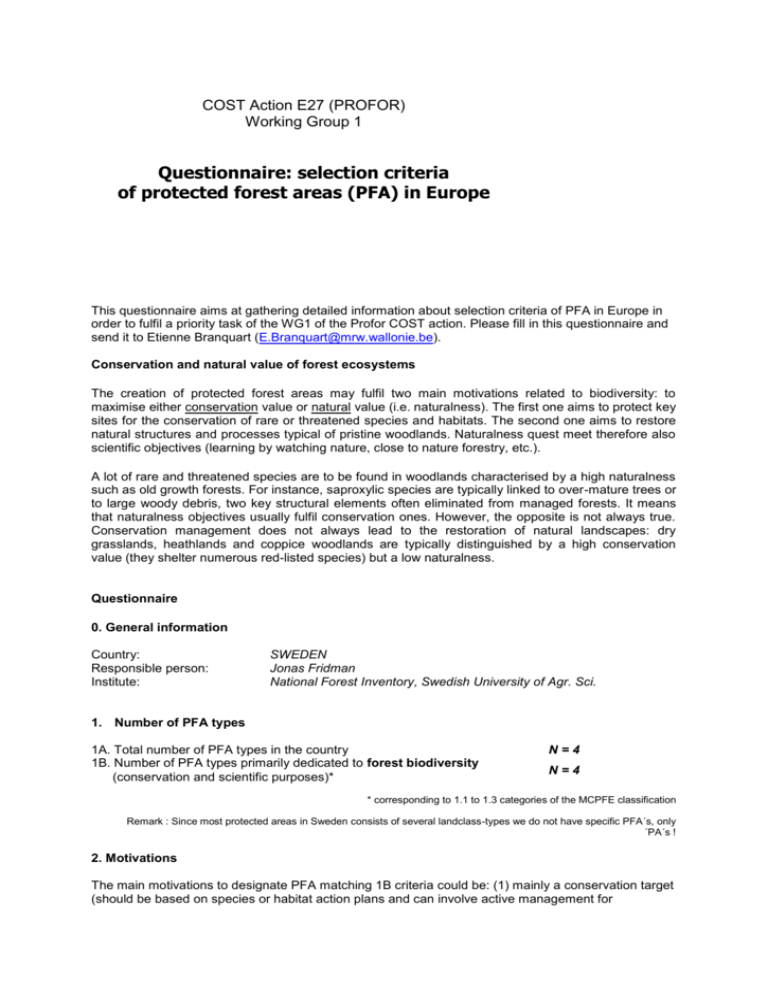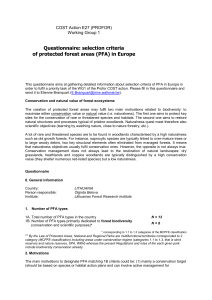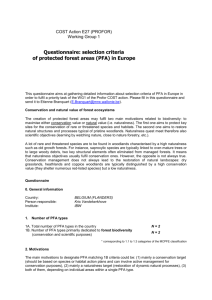Sweden - European Forest Institute
advertisement

COST Action E27 (PROFOR) Working Group 1 Questionnaire: selection criteria of protected forest areas (PFA) in Europe This questionnaire aims at gathering detailed information about selection criteria of PFA in Europe in order to fulfil a priority task of the WG1 of the Profor COST action. Please fill in this questionnaire and send it to Etienne Branquart (E.Branquart@mrw.wallonie.be). Conservation and natural value of forest ecosystems The creation of protected forest areas may fulfil two main motivations related to biodiversity: to maximise either conservation value or natural value (i.e. naturalness). The first one aims to protect key sites for the conservation of rare or threatened species and habitats. The second one aims to restore natural structures and processes typical of pristine woodlands. Naturalness quest meet therefore also scientific objectives (learning by watching nature, close to nature forestry, etc.). A lot of rare and threatened species are to be found in woodlands characterised by a high naturalness such as old growth forests. For instance, saproxylic species are typically linked to over-mature trees or to large woody debris, two key structural elements often eliminated from managed forests. It means that naturalness objectives usually fulfil conservation ones. However, the opposite is not always true. Conservation management does not always lead to the restoration of natural landscapes: dry grasslands, heathlands and coppice woodlands are typically distinguished by a high conservation value (they shelter numerous red-listed species) but a low naturalness. Questionnaire 0. General information Country: Responsible person: Institute: SWEDEN Jonas Fridman National Forest Inventory, Swedish University of Agr. Sci. 1. Number of PFA types 1A. Total number of PFA types in the country 1B. Number of PFA types primarily dedicated to forest biodiversity (conservation and scientific purposes)* N=4 N=4 * corresponding to 1.1 to 1.3 categories of the MCPFE classification Remark : Since most protected areas in Sweden consists of several landclass-types we do not have specific PFA´s, only ´PA´s ! 2. Motivations The main motivations to designate PFA matching 1B criteria could be: (1) mainly a conservation target (should be based on species or habitat action plans and can involve active management for conservation purposes), (2) mainly a naturalness target (restoration of dynamic natural processes), (3) both of them, depending on individual areas within a single PFA type. Please fill in the following table for the PFA types primarily dedicated to the conservation of forest biodiversity (cf 1B). In the last column (prime motivation), indicate (1)-(3), according to the description here above. Table 1 – Main local types of PFAs primarily dedicated to the conservation of forest biodiversity PFA code A B C D E F G PFA local name Nature Reserve National Park Woodland key-habitats with biotope protection Nature conservation areas MCPFE category Prime motivation (1, 2 or 3) 1.1 – 1.3, B 1.2 1.2 B 3 3 1 2 Comments: 3. Use of scientific selection criteria 3A. Are scientific standardised criteria currently used for the selection of PFA in your country ? No ....... 3B. Do they prevail on pragmatic criteria (e.g. site history, owner and availability) ? - .............................. 3C. Since when are scientific criteria used for site designation ? - ........................................................... Comments: In practice no scientific criteria is used, the main goal for the Swedish Environmental Protection Agency is to protect as much of the remaining old growth (or newr old-growth) forest. Therefore the stand age is primarily used for selection. 4. Types of selections criteria For each of the PFA types considered in Table 1, fill in the following table. Please use the following grading: (1) primary importance, (2) incidental importance and (3) not taken into consideration. Criteria definition 1A/ Habitat representativity: does PFA selection process aims to contain a representative selection of all forest types present in the country? 1B/ Threatened habitats: does PFA selection process focus on rare and threatened habitats (e.g. prioritary Natura 2000 habitats)? 1C/ Phytocoenotic integrity: does PFA selection process focus on forest sites with a representative and undisturbed vegetation (potential natural vegetation)? 1D/ Presence of signal species: are indicator species of natural conditions (forest continuity and integrity) used for PFA selection in your country? 1E/ Presence of red listed species: does PFA selection process focus on specific rare and threatened species (e.g. Natura 2000 species)? 2A/ Vertical and age structure: is a complex vertical and age structure a prerequisite for PFA selection? Do all the forest developmental phases have to be represented into individual reserves? 2B/ Natural regeneration: is the presence of large amounts of young trees and saplings another prerequisite? 2C/ Old growth stages: does the selection process focus on old-growth areas characterised by the presence of overmature trees and minimal amount of dead wood? 2D/ Soil and hyrdology integrity: does PFA selection process focus on sites with undisturbed soils and hydrology, including water quality and drainage? 3A/ Forest cover continuity over time: does PFA selection process focus on ancient forests with a long cover continuity over time? 3B/ Old-growth continuity over time: ditto, with a continuity in over-mature trees and dead wood within the forest. 3C/ Minimal area for PFA designation: is a minimal structural area a prerequisite for PFA selection? 3D/ PFA environment and buffer area: is PFA environment taken into account before site selection ? Has it to be included in a larger forest areas to fulfil connectivity requirements ? Has it to be remote from roads and pollution sources ? Etc. 3E/ Habitat diversity within PFA: does PFA selection process focus on habitat complexes made of various habitat types? 3F/ Landform and topography: are PFA concentrated in particular landforms (mountains, flood plains, etc.)? Table 2 – Main selection criteria for PFA dedicated to biodiversity conservation A B C D 2 1 3 2 2 2 1 3 2 2 2 1 3 2 1 3 1 3 2 2 2 2 1 3 2 2 1 3 2 2 1 3 2 2 1 3 2 2 2 2 2 2 2 2 1 2 2 2 2 2 3 2 3 3 2 2 3 1/ Composition 1A. Habitat representativity 1B. Threatened habitats 1C. Phytocoenotic integrity 1D. Presence of signal species 1E. Presence of red listed species 2/ Structure/functioning 2A. Vertical and age structure 2B. Natural regeneration 2C. Old-growth stages 2D. Soil and hydrology integrity 3/ Landscape ecological context 3A. Forest cover continuity over time 3B. Old-growth continuity over time 3C. Minimal area for PFA designation 3D. PFA environment and buffer area 3E. Habitat diversity within individual PFA 3F. Landform and topography 2 3 3 E F G Are there other primary scientific criteria used for site designation that have been omitted in the Table 2 ? No 5. Quantitative assessment For those criteria of primary importance for PFA selection ((1) in Table 2), explain hereafter how they are assessed and which benchmarks, references and international or national standards are used. For example, if minimal structural area is considered as a priority for the designation of some PFA type, give some indicative value of the minimum size. Criterion 1 = Threatened Habitats; Assesment of habitat type for the potential PFA can be made using aerial-photos, satellite images and/or field work. Identification of which habitats that are threatened are often made by the regional county boards/forest boards using several sources, i.e. swamp forest inventories, old-growth forest inventories and key-biotope inventories. Identification on the country level can be made using NFI-data, occasionally also in combination with satellite-data. Criterion 2 = Presence of Red listed species; Initial identification of Woodland key-habitats is made using IR-aerial photos. Field work is then performed for identification of presence of red-listed species OR if prerequisites for red-listed species can be found (http://www.svo.se/minskog/templates/svo_se_vanlig.asp?id=9415). The Official Swedish Red-data list is used (http://www.artdata.slu.se/redlist.htm) Criterion 3 = Old-growth stages; Identification of old-growth forests are often made by the regional county boards/forest boards using several sources, i.e. old-growth forest inventories and key-biotope inventories. Identification on the country level can be made using NFI-data, occasionally also in combination with satellite-data. Criterion 4 = Minimal area for PFA designation: National Park appr. 20 ha Criterion 5 = Criterion 6 =







